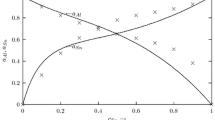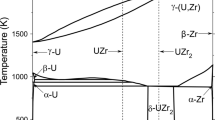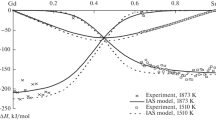Abstract
Thermodynamic, microscopic and surface properties of liquid Sn–Zn alloys at 750 K are reviewed in the framework of different statistical mechanical models. Flory’s model and quasi-chemical approximation (QCA) have been considered to deduce information on the concentration dependence of the thermodynamic and structural properties. The size-dependent atomic interaction has got special attention in Flory’s model, while in QCA the atomic interaction leading to the formation of like-atom clusters is assumed. Both models predict almost the same value of the interaction energy parameter in the Sn–Zn alloys, and it is found to be temperature dependent. The asymmetry in the thermodynamic properties of the alloys is explained to a great extent, and the analysis of the microscopic properties suggests that the Sn–Zn alloys are weakly segregating in nature throughout the whole range of the composition. Meanwhile, the validity of these models in describing the thermodynamic behaviour of the alloys is also examined. QCA is found to be more appropriate choice for the study of the energetics of the Sn–Zn alloys at 750 K. The comparative analysis of the surface properties under different assumptions reveals that self-associating mixture method better explains the surface behaviour in the alloys. The study indicates nonlinear variation in the concentration dependence of both the surface concentration and the surface tension of the alloys. The surface tension is found to increase with increase in Zn concentration, and the surface of the alloys is enriched with Sn atoms which segregate to the surface.







Similar content being viewed by others
References
H. Ezaki, T. Nambu, R. Ninomiya, Y. Nakahara, C.Q. Wang, M. Morinaga, J. Mater. Sci. Mater. Electron. 13, 269 (2002). doi:10.1023/A:1015555505709
U.R. Kattner, JOM 54, 45 (2002). doi:10.1007/BF02709189
K. Suganuma, K.-S. Kim, J. Mater. Sci. Mater. Electron. 18, 121 (2007). doi:10.1007/s10854-006-9018-2
Z. Moser, J. Dutkiewicz, W. Gasior, J. Salawa, Bull. Alloys Phase Diagr. 6, 330 (1985). doi:10.1007/BF02880511
K. Suganuma, K. Niihara, T. Shoutoku, Y. Nakamura, J. Mater. Res. 13, 2859 (1998). doi:10.1557/JMR.1998.0391
T. Nahlawi, Tin-Zinc Alloys Plating System, Sustainable Surface Engineering, ASETS Defense, New Orleans, Louisiana, USA, 8–10 February 2011
R. Hultgren, P.D. Desai, D.T. Hawkins, M. Gleiser, K.K. Kelly, Selected Values of the Thermodynamic Properties of Binary Alloys (ASM, Metal Park, Ohio, 1973), p. 1333
I.S. Jha, D. Adhikari, J. Kumar, B.P. Singh, Phase Transit. 84, 1075 (2011). doi:10.1080/01411594.2011.574913
P.J. Flory, J. Chem. Phys. 10, 51 (1942). doi:10.1063/1.1723621
I.S. Jha, A.K. Khan, B.C. Kumar, BIBECHANA 7, 26 (2011). doi:10.3126/bibechana.v7i0.4040
R.N. Singh, Can. J. Phys. 65, 309 (1987). doi:10.1139/p87-038
R.N. Singh, F. Sommer, Rep. Prog. Phys. 60, 57 (1997). doi:10.1088/0034-4885/60/1/003
B.C. Anusionwu, C.A. Madhu, C.E. Orji, Pramana- J. Physics 72, 951 (2009). doi:10.1007/s12043-009-0088-6
L.C. Prasad, R.N. Singh, G.P. Singh, Phys. Chem. Liq. 27, 179 (1994). doi:10.1080/00319109408029523
B.C. Anusionwu, E.O. Ilo-Okeke, J. Alloys Comp. 397, 79 (2005). doi:10.1016/j.jallcom.2004.12.048
L.C. Prasad, R.K. Jha, Phys. Stat. Sol. 202, 2709 (2005). doi:10.1002/pssa.200520080
L.C. Prasad, Y. Xie, A. Mikula, Non-Cryst. Solids 250, 316 (1999). doi:10.1016/S0022-3093(99)00255-0
R. Novakovic, Non-Cryst. Solids 356, 1593 (2010). doi:10.1016/j.jnoncrysol2010.05.055
N.H. March, J.A. Alonso, Phys. Chem. Liq. 46, 522 (2008). doi:10.1080/00319100801930466
E. Ricci, S. Amore, D. Giuranno, R. Novakovic, A. Tuissi, N. Sobczak, R. Nowak, B. Korpala, G. Bruzda, J. Chem. Phys. 140, 1 (2014). doi:10.1063/1.4879775
W.-H. Shih, D. Stroud, Phys. Rev. B 32, 804 (1985). doi:10.1103/PhysREvB.32.804
Z. Moser, W. Gasior, J. Pstrus, J. Electron. Mater. 30, 1104 (2001). doi:10.1007/s11664-001-0136-6
S. Amore, J. Brillo, I. Egry, R. Novakovic, Appl. Surf. Sci. 257, 7739 (2011). doi:10.1016/j.apsusc.2011.04.019
D. Adhikari, Phase Transit. 84, 308 (2011). doi:10.1080/01411594.2010.536088
B.P. Singh, R.P. Koirala, I.S. Jha, D. Adhikari, Phys. Chem. Liq. 51, 247 (2013). doi:10.1080/00319104.2012.747200
A.B. Bhatia, R.N. Singh, Phys. Chem. Liq. 11, 285 (1982). doi:10.1080/00319108208080752
B.C. Anusionwu, Phys. Chem. Liq. 42, 245 (2004). doi:10.1080/00319100410001657624
S. Chaubey, Indian J. Eng. Mater. S. (IJEMS) 16, 364 (2009)
B. Karaoglu, W.H. Young, Phys. Chem. Liq. 30, 187 (1995). doi:10.1080/00319109508031653
D. Adhikari, I.S. Jha, B.P. Singh, Phil. Mag. 90, 2687 (2010). doi:10.1080/14786431003745302
E.A. Brandes (ed.), Smithells Metals Reference Book, 6th edn. (Butterworths, UK, 1983), pp. 6–14
Acknowledgments
One of the authors (R.P. Koirala) is thankful to the University Grants Commission (UGC), Nepal, for providing financial support under Mini Research Project [Grant Ref. No. 61-2071/04/30] to pursue the research. Further he extends his sincere gratitude to Prof. Dr. Pradeep Raj Pradhan (Postgraduate Department of Physics, M.M.A.M. Campus, Tribhuvan University, Biratnagar, Nepal), Prof. Dr. Ashok Kumar (Postgraduate Department of Physics, M.M.A.M. Campus, Tribhuvan University, Biratnagar, Nepal, and Prof. Dr. L.N. Jha (Former Head, Central Department of Physics, Tribhuvan University, Kirtipur, Nepal) for their fruitful suggestions and encouraging discussions.
Author information
Authors and Affiliations
Corresponding author
Rights and permissions
About this article
Cite this article
Singh, B.P., Koirala, R.P., Jha, I.S. et al. Thermodynamic, structural and surface properties in Sn–Zn melt at 750 K. Appl. Phys. A 120, 1347–1356 (2015). https://doi.org/10.1007/s00339-015-9316-8
Received:
Accepted:
Published:
Issue Date:
DOI: https://doi.org/10.1007/s00339-015-9316-8




